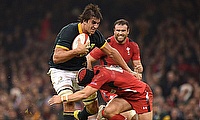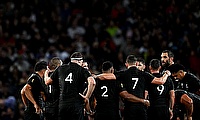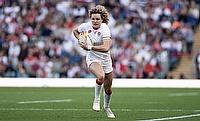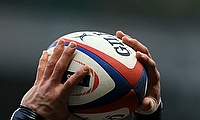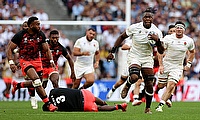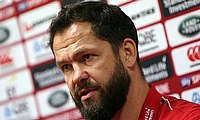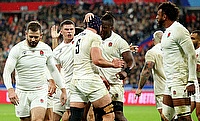2017 British & Irish Lions potential XV
With the Six Nations sides on a bye week, we decided to put together a British and Irish Lions XV for their 2017 tour to New Zealand, factoring in current form and prospective standing in the game in two years’ time.
The choice of the Lions’ head coach will obviously affect the starting XV, but we have tried to put all allegiances and biases aside to pick the best possible XV to take on the All Blacks in 2017.
Feel free to let us know what you think of the XV and what changes you would make!
1. Joe Marler, England
On current form this looks to be a two-horse race between Marler and Ireland’s Cian Healy, but the likes of Mako Vunipola, Alex Corbisiero, Rob Evans and Jack McGrath will all likely compete for a place on the tour. It’s hard to separate Marler and Healy, and although Healy would probably start if the game was tomorrow, the prospect of just how good Marler could be in two years’ time is an exciting thought.
In terms of scrummaging ability, there is very little between the two, but Healy certainly offers more in the loose right now. Marler’s role as current Harlequins captain also makes him an intriguing dark horse for captaincy of the Lions in 2017, depending on who else is selected/available for the tour.
2. Dylan Hartley, England
Two wildcards for this spot are Luke Cowan-Dickie and Duncan Casey, both of whom could be the starting hookers for England and Ireland respectively by this point, but Hartley’s experience gives him the nod. Rory Best will be 34 in 2017, whilst Richard Hibbard will be 33, and considering how much their games revolve around their ability in the loose, it is fair to assume there could be a drop off in their performances by this time.
Hartley, for all the concerns over his discipline, is the most well-rounded hooker currently playing in the northern hemisphere, offering consistent precision at the set-piece as well as a willingness to do the hard work in the loose.
3. Samson Lee, Wales
Injuries have become an issue in recent years for Dan Cole, whilst Samson Lee is one of the best scrummaging prospects we have seen in years, making the decision to start Lee – and use Cole as an impact sub – an obvious one. Kyle Sinckler, Martin Moore, David Wilson and Henry Thomas will also likely be in the conversation.
Lee rounds out a very formidable looking front row and if both he and Marler continue to develop as they have done so far, it’s hard to imagine New Zealand being able to match-up in the scrum, potentially giving the Lions a much-needed advantage in the Land of the Long White Cloud.
4. Jonny Gray, Scotland
The younger Gray brother sees off competition from his older brother Richie, Welsh leader Alun Wyn Jones and Irish dynamo Iain Henderson. Similar to the Lee/Cole selection decision, the impact that Henderson can bring with his powerful carries and solid tackling off the bench, particularly against tired opposition, could well prove to be a difference-maker.
Gray has already shown himself to be a fine international second row and as with Marler and Lee, the potential of where he could be in two years’ time is an extremely appetising thought for fans of the home nations. He is the prototypical modern lock that can do everything well, and doesn’t subscribe to the traditional roles of being either an enforcer or a lineout technician.
5. Courtney Lawes, England
Lawes faces stiff competition from two of his national compatriots, Joe Launchbury and Maro Itoje, but at his best, can be talked about in the same conversation as the likes of Sam Whitelock and Eben Etzebeth, and perhaps even Brodie Retallick. This spot will likely be dictated by whoever is favoured by England at the time, with all three locks capable being amongst the very best in the world. It’s a big reach to make, but if Itoje is starting for England, don’t rule him out of being in the captaincy debate, such as is the authority and natural leadership the 20-year-old projects.
Assuming Lawes is still packing down in England’s engine room in 2017 however, he would make a great foil to the industrious Gray. Lawes is as good as the northern hemisphere has to offer defensively, making thunderous hits with abandon as well as stealing lineout ball with regularity thanks to his great athleticism.
6. Peter O’Mahony, Ireland
Clearly the best blindside flanker amongst the home nations as things stand, O’Mahony’s greatest challenge could come from Scotland’s Rob Harley. Harley doesn’t get the attention that his teammate Blair Cowan does, but the role he plays in Scotland’s back row is pivotal to helping the team around him succeed. There’s also a ring to Sam Burgess, British and Irish Lions blindside flanker.
That said, O’Mahony is the complete blindside flanker. His tackling technique is flawless, his work rate is peerless and he can make a real impact at the breakdown, and given the strength New Zealand will undoubtedly bring to bear at the contact area, having as many skilled breakdown forwards as possbile will be pivotal. O’Mahony would also offer another captaincy candidate, particularly if he becomes a little more coolheaded over the next two years.
7. Sam Warburton, Wales
A victorious British and Irish Lions captain, not to mention the most technically-refined openside flanker in the northern hemisphere, Warburton’s selection seems like no-brainer. The dynamism of Sean O’Brien makes him a perfect impact sub, whilst Cowan would bring local knowledge to the squad and will likely be in the mix. James Davies and Jordi Murphy are two options that may surprise, but Davies is on the path to stardom, whilst Murphy offers positional versatility.
Warburton would likely be the frontrunner for captaincy, having done such a good job in that role in 2013, particularly if Warren Gatland was the man to coach the 2017 tour. A duel with Sam Cane or Ardie Savea would beckon for Warburton and given the ability they have over the ball, opting for an out-and-out breakdown specialist at seven is all but a must.
8. Nathan Hughes, England
England would almost certainly be starting this young man right now if he was already qualified on residency, but he will be come 2016 and a year of pulling on the red rose should be enough to convince whomever coaches the Lions that he is the man to pack down at the base of the scrum. Jamie Heaslip will be 33 and possibly usurped in the Irish pecking order by CJ Stander and/or Jack Conan, whilst Hughes’ fellow Polynesian stars Taulupe Faletau and Billy Vunipola would be solid bets to join him on the plane.
Hughes has the offloading game of his native Fiji down to a tee, whilst his time in England with Wasps has seen dramatic improvements to his stamina, defensive awareness and all-round game. The number eight boasts impressive physicality with ever-improving technique and would also not be at all shied by playing in a country where he learnt his trade as a rugby player.
9. Conor Murray, Ireland
At 28 years of age come the tour, Murray will be slap bang in the middle of his prime. Rhys Webb should provide plenty of competition, as could Ben Youngs and Danny Care, but it’s hard to see the starting spot going to anyone but Murray right now. Don’t rule out a spot on the tour for Sam Hidalgo-Clyne, either.
Murray has the all-round skill set to succeed in New Zealand and can adapt to whatever gameplan the Lions choose to implement down under. The Irish scrum-half has the running game and distribution to facilitate a potent Lions attack, but also the kicking game to alleviate pressure when they’re on the back foot.
10. Jonathan Sexton, Ireland
Another no-brainer here, as Sexton is clearly the leading candidate for the role now and it’s difficult to see that changing over the next two years. Wales’ Dan Biggar and England’s Owen Farrell and George Ford would probably be favourites to back-up Sexton as of right now, but Henry Slade and Finn Russell could also be in contention. Gareth Anscombe shouldn’t be ruled out, as much for his local knowledge, as for his positional versatility.
Pinpoint kicking, an ability to unlock defences and solid tackling, Sexton brings everything needed to beat New Zealand on their own patch and would form a familiar partnership with Murray in the half-backs.
11. George North, Wales
Wales may not always use North in the most effective way, but any doubts over whether or not North belongs in this squad will be erased with a quick viewing of his one-on-one with Israel Folau from 2013. Simon Zebo poses the biggest threat to North, especially with the defensive side of his game improving significantly as of late. A real wildcard here, but don’t be surprised to see Nathan Earle involved, who could be fast-tracked into the England set-up if he can impress for Saracens, such is his ability and England’s need to lock down their preferred wingers.
The Welsh winger is the most potent weapon out wide that the northern hemisphere has, thanks to a combination of his tackle-shedding power and blistering speed. North will be 25 by the time of the tour, looking to win his second Lions tour and will probably have amassed about 75 caps fitness-permitting.
12. Robbie Henshaw, Ireland
It was a tough call not going with Jamie Roberts, who already has two tours under his belt, but the Welshman would almost certainly feature in the squad, bringing a wealth of experience to the fray. Scotland’s Alex Dunbar will be knocking on the door, as could a number of Englishmen, including Sam Hill, Kyle Eastmond and Luther Burrell.
The decision to go with Henshaw over Roberts owes as much to the half-back selections as anything. The consistency of a Murray-Sexton- Henshaw axis would be a big fillip for the Lions, who often struggle for understanding early on. Henshaw has impressed everyone with his defensive work so far for Ireland and chances are his attacking game will have caught up with it come 2017.
13. Manu Tuilagi, England
This pick comes with the considerable caveat that Tuilagi is fit for the tour, something which is far from guaranteed given the amount of injuries he has suffered in recent years. Should Tuilagi not be fit, Jonathan Joseph and Jonathan Davies are both very solid options, but the frontrunner could well be Scotland’s Mark Bennett, who has made great strides over the last year and is still only 22 years old.
When fit, Tuilagi is amongst the most dangerous players in world rugby and has run New Zealand ragged on two occasions, thanks to his dynamic carrying and ferocious blitz defence. Whilst the All Blacks would not openly admit to fearing anyone, there’s no doubt the presence of Tuilagi in the Lions’ lineup would worry Steve Hansen and his charges.
14. Anthony Watson, England
Watson is yet to cement himself as England’s right wing, let alone the Lions’, but with Tommy Bowe advancing in age and Alex Cuthbert’s stock falling, Watson makes the most sense. He’ll be pushed hard by those two and Scotland’s Tommy Seymour, who is vastly underappreciated globally, but the scope of where Watson could be in two years’ time is enough to swing it in his favour.
Though a natural full-back, England’s need for wingers has forced Watson into the right wing role and that could turn out to be the Lions’ gain in 2017. If you give Watson an inch, he’ll take a yard and he possesses arguably the best pair of feet England have seen since Jason Robinson, able to dance his way out of tackles and then has the afterburners to turn those breaks into big gains.
15. Leigh Halfpenny, Wales
Legitimate cases can be made that any of Rob Kearney, Stuart Hogg or Mike Brown should be starting here come 2017, but with the kicking game New Zealand like to dominate, Halfpenny is a horses for courses selection. Halfpenny or Kearney make the most sense to start given that facet of the game will be prevalent, but the attacking ambition of Hogg makes him the perfect choice to change things from the bench, especially with dynamic threats like Watson and North on his shoulder.
Both Halfpenny and Kearney are equally adept under the high ball, but Halfpenny’s slightly more proficient tactical kicking was all that separated the two. The full-back also knows North well, and would work well with the left wing.

